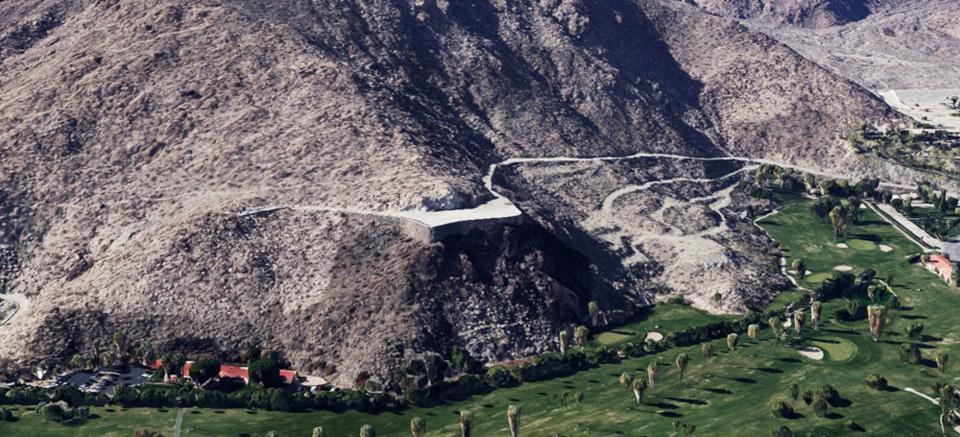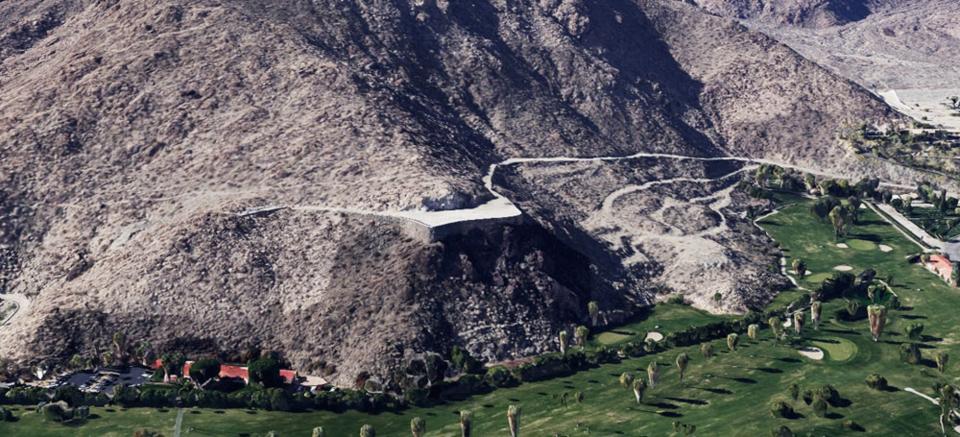From the archive: This story first published in The Desert Sun in December 2019.
Huell Howser thought it most mysterious, and therefore worthy of one of his first episodes on the Coachella Valley. Howser gazed up at the mountainside, like countless visitors before and after him, and wondered.
In 1953, The Desert Sun explained the mystery that Howser encountered, “virtually every visitor to Palm Springs stops among the Cadillacs and smart specialty shops on palm-lined Palm Canyon Drive to lift a finger and an enquiring voice in the question, ‘What’s that up there?’” Advising residents on responding humorously but accurately about how hard it was to respond to that seemingly simple question, the paper advised answering: “’That? Oh, that’s O’Donnell’s Lookout’…then quickly walk away.”
That? That was a man-made outcropping on the side of Mount San Jacinto that towered over Tom O’Donnell’s golf course. The magnitude of it equaled the magnificent mountainside and naturally commanded the attention of all those on the valley floor below.
Architectural historian Steven Vaught writes, “in 1933, the United States and the entire world were paralyzed by the global economic collapse known as the Great Depression. In 1929, before the October stock market crash shattered the world economy, the U.S. unemployment rate stood at 3.2%. Three years later it had risen to 24.9%, the highest recorded rate in U.S. history, with virtually every corner of the country affected.
Palm Springs had fared better than most owing to its continued popularity with the wealthy, but that did not mean the region was not adversely affected. Tourism had dropped considerably and new building and civic programs had virtually ground to a halt.”
In the height of the Depression, Tom O’Donnell conceived of a make-work project in order to employ anyone who needed work. A decade earlier, he had built his home on the hillside behind The Desert Inn. Requiring dynamite to carve out a shelf for the house, and a massive stacked stone wall backfilled to create a floating terrace for the house’s front yard, he understood the difficulties of building against gravity on the mountain.

A similar earthwork would certainly sustain a good number of villagers for a good number of years. O’Donnell had been born in modest, if not impoverished, circumstances. Having made an incredible fortune in the oil business, throughout his life he found as much pleasure in his associations workers and laborers as he did with presidents of the United States and captains of industry.
The Great Depression wreaked havoc throughout the country and showed no signs of abating. By 1934, O’Donnell looked for ways to provide relief. The stigma of receiving a handout was unbearable, people wanted work.
O’Donnell followed the precepts of the Roosevelt administration in providing dignity through work to displaced and despairing people with the creation of the Works Progress Administration and the Civilian Conservation Corps. O’Donnell decided to embark on what one writer called “his own personal WPA project.”
On the mountain property to the north of his house, and above his golf course, O’Donnell entrusted John Kline, his friend and groundskeeper with the project. The Desert Sun thought it “one of the most monumental projects ever undertaken here.” The project took on various names including the “Promontory,” “Lookout” and “Inspiration Point.”
Kline was responsible for hiring and supervising the men on the project, which would constitute a force of some two dozen. The men were to be paid $2.50 a day, enough to sustain a family. Kline worked alongside his grateful men.
The 1961 Desert Sun article offered a rare chance to actually learn the names of a handful of the talented workers who built Inspiration Point: Frank Reyes, Luis Gutierrez, Aepimento Onopa, Victor Moreno, Merced Ortega, Jose Chacon, Manuel Fontez, Felix Torres, Manual Camarillo, George Bernal, and Alizdado Garcia, were among those who toiled on the project.
The crew used picks, jackhammers and dynamite to blast away at the granite mountainside. The resulting rubble was then broken up further and sized for use creating the brobdingnagian retaining wall. Any remaining debris was used to fill the space between the walls and the mountain slope.
Vaught writes, “considering the roughness of the site and materials involved, the completed Inspiration Point gave a surprisingly graceful curving appearance that could almost be called Art Deco.” To add to the architectural appeal, a waist-high perimeter wall was built featuring 105 triangular fenestrations running the length of the massive wall. As had been done with O’Donnell’s home, great care was taken that the construction would blend into the mountain from which it was carved.
Some construction continued at least until 1940. That year, the Desert Sun assured villagers that the blasting and dust clouds seen on the hillside were not the work of enemy bombers, but were “to help in the work of finishing the road and bench project on the Thomas O’Donnell property on the commanding elevation over the Desert Golf Course.”
O’Donnell arrived on the desert in 1924 and loaned Nellie Coffman the $350,000 she needed to expand and improve The Desert Inn in exchange for supervising the building of his home on the mountainside. His arrival was only a few years after the beginning of the Easter Sunrise service in 1917. After the completion of the house, O’Donnell allowed the townspeople onto the golf course and the hiking trail and driveway leading to his house, to look east for the rising sun and hear the services.
Nellie Coffman installed a large white cross on the hillside and positioned the choir below. The event drew thousands of people growing larger for decades and attracting national attention. For a number of years, the services were simulcast across the country by one of the national networks.
In 1947, the Easter Sunrise services were moved to Inspiration Point. Bleachers were built for the choir. The Boy Scouts were drafted into service to usher guests. Equipment was installed to broadcast the services over station KCMJ. By the 1960s, Dwight D. Eisenhower would come from Eldorado Country Club to witness the event. For the 50th anniversary program in 1967, the trumpet called out at dawn signaling the release of 150 doves into the brightening sky.
The history of Inspiration Point was recounted by Huell Howser for his episode solving the mystery of the landmark project that caused so many visitors to look to the mountain and wonder.
On Thursday, Dec. 19, the Palm Springs City Council will consider historic designation for Inspiration Point. It is ostensibly so and is aptly named, serving as an enduring monument to Tom O’Donnell’s generosity and the unrivaled industriousness of the poor, and rightly proud, minority residents of the desert during the Depression.
More: Eldorado Country Club and golf course lives up to its name
This article originally appeared on Palm Springs Desert Sun: Palm Springs history: Inspiration Point on Mount San Jacinto
EMEA Tribune is not involved in this news article, it is taken from our partners and or from the News Agencies. Copyright and Credit go to the News Agencies, email news@emeatribune.com Follow our WhatsApp verified Channel





